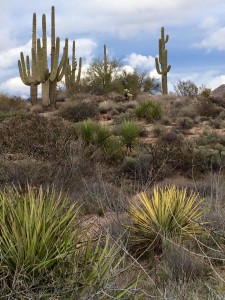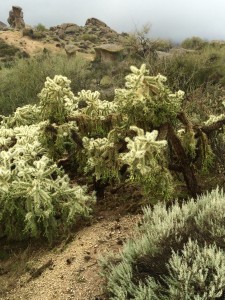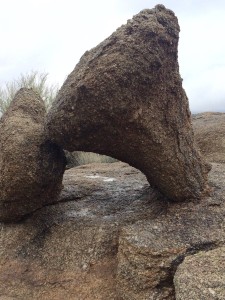Except for some brief stops at the Phoenix, Arizona, airport, I hadn’t been in the “Valley of the Sun” region for about 30 years until recently, when some friends invited us to spend a few days in their timeshare at the Sheraton Desert Oasis resort in Scottsdale, which lies north and east of Phoenix.
My memories of the area weren’t particularly positive. Our previous Phoenix visit — poorly timed for August, when it was 110 degrees in the shade — was spent futilely searching for the “there” there, to paraphrase Gertrude Stein. If there was a downtown Phoenix, we couldn’t find it back then. It just seemed to be a mass of sprawl in the desert.
Because I had imagined Scottsdale to be just another Phoenix suburb, I wasn’t expecting much in the way of sightseeing or activities. I knew it had a reputation for expensive resorts, spas, and golf courses, but otherwise Scottsdale wasn’t on my radar.
It should have been. My wife, Catharine, and I love outdoor activities, especially hiking, and Scottsdale is an ideal place for it — amid splendors of the desert that take your breath away.
Scottsdale’s Attractions
Many people who haven’t spent time in the desert picture it to be just a flat, often bleak expanse of sand that’s hot and dusty to boot. And to be sure, there are vast stretches of desert in parts of Arizona and California that are just that. Driving through these regions of the Sonoran and Mojave deserts, passing occasional remote settlements, you find yourself mumbling “Who on earth would live there?”
But deserts are alive with flora, fauna and geologic wonders that are on prominent display in places like Saguaro National Park in Tucson and Joshua Tree and Death Valley national parks in southern California.
And, we discovered, in Scottsdale, Arizona.
Scottsdale is huge — the city spans about 30 miles north to south and about 11 miles east to west, harboring well over 200,000 residents along with scads of multi-million-dollar homes, some 200 golf courses, and dozens of high-end resorts and spas. It’s also won acclaim for its arts scene, museums, restaurants, rodeos, shops, vibrant nightlife, and its Western-themed Old Town.
It bills itself as “The West’s Most Western Town,” and millions of tourists — many of them baby boomers — flock here every year.
But back around 1950, Scottsdale was a five-square-mile burg of 2,000 people. The population growth has been spurred in large part by chilly northern “snowbirds” fleeing to the winter warmth, and often settling down here year-round.
Preserving the Desert
Unlike many cities that failed to control their growth, the city of Scottsdale did something very smart back in the 1990s: it established the McDowell Sonoran Conservancy, which has since set aside some 47 square miles of mountainous desert land for recreational purposes. Scottsdale’s McDowell Sonoran Preserve is now the largest urban preserve in the United States — covering more land than the adjacent cities of Tempe and Paradise Valley combined.
Hikers, rock climbers, mountain bikers, horseback riders, and just folks out for a Sunday stroll in beautiful surroundings can take advantage of dozens of trails heading off into the rugged McDowell Mountains, with a wide variety of terrain and degrees of difficulty.
The preserve is located on the northern fringes of the city, near the Sheraton Desert Oasis where we stayed, and stands adjacent to other parks and preserves offering yet more trails.
Since a few baby boomers in our group were battling knee and back problems, we stuck to some easy-to-moderate trails, including an excellent nature trail loop near the Gateway visitor center that gave us insights into the fascinating but often-overlooked variety of Sonoran Desert plants and animals. Here are a few interesting nuggets:
- Saguaro cacti — the largest members of the cactus family that grow only in the Sonoran Desert of southern Arizona, northern Mexico, and parts of California — are extremely slow-growing and don’t begin to sprout their distinctive tree-like “arms” until they reach the age of 50 or 60. Saguaros can live to be up to 200 years old and weigh up to 3,000-4,000 pounds, with as many as 25 “arms.”
- “Jumping” chollas — a type of cactus reputed to shoot its needle-like spines at passersby who wander too close — actually don’t jump at all, but they do attach themselves very easily to anyone who brushes up against them. (Just ask our friend Tom, who spent much of one hike picking cholla spines out of his trousers). Small wrens often build their nests in the jumping chollas but know how to avoid the spines — which their prospective prey do not.
- A type of desert creosote bush can live to be more than 11,000 years old, making it one of the earth’s oldest living things; many people think it smells like rain, while others find its odor offensive.
- Sonoran grasshopper mice are carnivorous and like to dine on venomous creatures like scorpions, tarantulas, and snakes. They also like to howl at the moon at night and have a territorial range of 25 square miles or more.
- And my favorite, since I identify all too much with them: desert packrats, much like human hoarders, really do gather a mix of debris and shiny objects (“treasures”) and create nests, known as “middens,” from them to live in. The nests can reach several feet high and wide and may contain stray keys and pieces of tin foil they’ve gathered because, well, they may come in handy some day.
We also followed the three-mile-roundtrip Marcus Landslide Trail, a well-maintained interpretive trail that led to an area of huge boulders that had slid down a mountainside some 500,000 years ago, but was only fairly recently discovered by a pair of college students. Geologists believe that the brief landslide equaled the explosive power of an atom bomb. The trail also features a wide variety of cacti of all shapes and sizes that will flower in the spring — peak season here for hikers. We also spotted cottontail rabbits, hawks, and lizards.
Travel Tip of the Day: After hiking, we enjoyed two meals at the Pinnacle Grille, in the shadow of distinctive Pinnacle Peak, where you can build your own salads and burgers or order delicious soups and sandwiches. Breakfast was also bountiful, the folks there were friendly, and they have both indoor and outdoor dining. Highly recommended.
You might also be interested in this recent guest post by the founder of Southwest Discoveries, who leads hiking tours in Arizona.















12 Responses to Scottsdale, Arizona: Splendor in the Desert